Jacopo, Paris | An Affordable French Take on Fast-Casual Dining, B-/C+
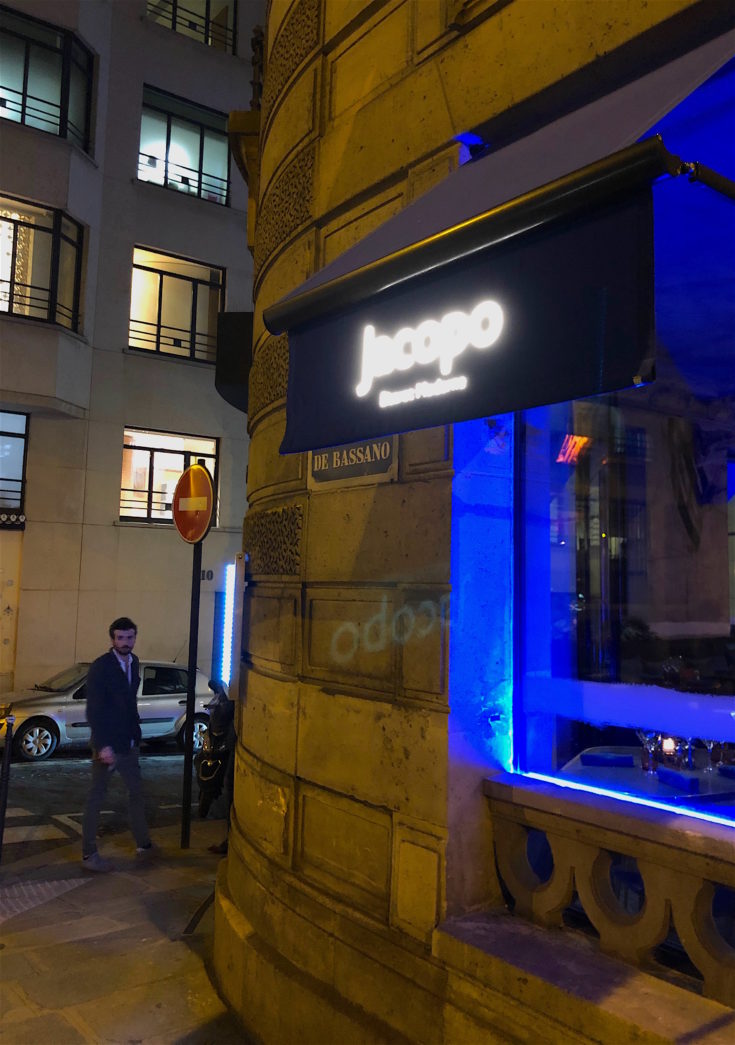
After reading several positive reviews of Jacopo, the new moderately priced bistro by Thibault Sombardier, a media-loving young chef who has a Michelin star at the seafood restaurant Antoine and who was also a contestant on Top Chef, the French dueling chefs television show, I met a friend for dinner with high expectations. The address in the rue Vernet in the 8th arrondissement seemed to auger well, too, since this street had once been the location of one of my favorite Paris restaurants, Les Elysees du Vernet at the Hotel Vernet when several superb chefs—notably Bruno Cirino of L’Hostellerie Jerome in La Turbie, successively made it a dark-horse favorite with a beautiful setting under a verriere (glass ceiling) design by Gustave Eiffel (this restaurant still exists and is today known as Le V, but I have no opinion on it today, since I haven’t dined here in at least ten years).
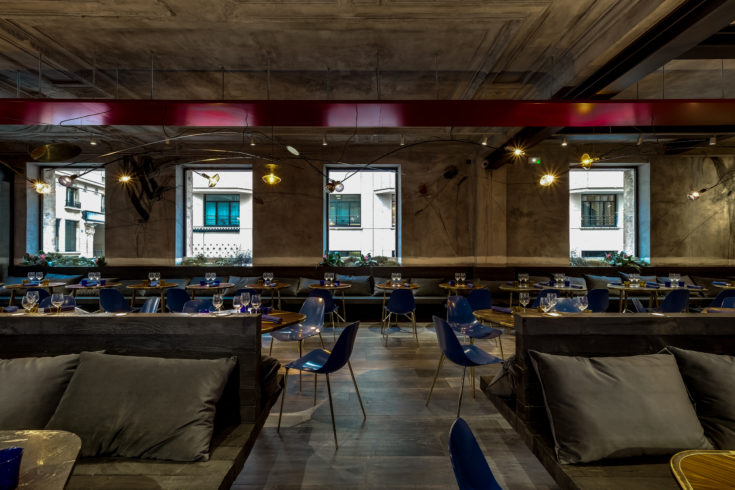
On the way to dinner I also found myself thinking that a decent bistro in this business-and-tourist district of the 8th Arrondissement along the Champs Elysees might spare some other hapless debutant visitor to Paris the ordeal that befell me on my first night in the French capital (mind you, I’m still eternally grateful to this day that my parents considered this trip to Europe to be an essential part of the education of their four children). On that steamy August night, however, a reunion meal was on the horizon, since my mother, two brothers and me were meeting my father and sister at a hotel just off the Champs Elysees after having traveled on our own for two months.
During those two months when Mom ran the show, we’d eaten exceptionally well, too, including a superb meal at Cipriani in Venice and another one at the Hotel Sacher in Vienna. For the occasion of her children’s first night in Paris, my mother, who had decided to throw caution to winds and spend a good chunk of an inheritance on this trip, had booked us at La Tour d’Argent. She wanted us to have an experience of French haute cuisine, the view of Notre Dame and the Seine by night, and the dozens of intricately stitched lessons in gastronomy, worldliness and gallantry such a meal would surely offer.
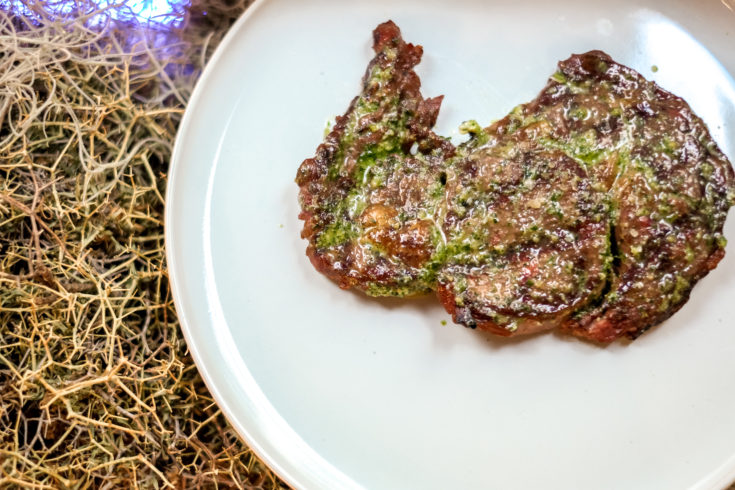
Steak at Jacopo
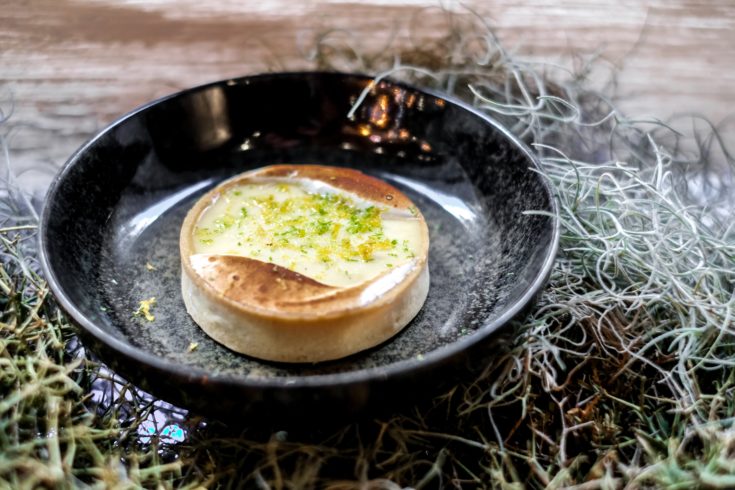
Lemon tart at Jacopo
Suffice it to say, my late father quickly reasserted himself as the family’s final arbiter of all things financial and told my mother to cancel the reservation, because it was, in his view, an absurdly extravagant and foolish place to take adolescent children. “Why don’t you children wait for us in the lobby downstairs,” my mother suggested.
So we sat in a strange row of four armchairs upholstered in some prickly fabric, and eventually they emerged from the elevator, my mother with tear-streaked cheeks first. We ended up walking down the street our hotel was located on and having a meal at the very same Pizza Pino that still exists at the corner of the Champs Elysees and the rue Marignan today (for the uninitiated, Pizza Pino, is a French pizza chain that’s not even on par with such sorry options as Pizza Hut or Sbarro). For ferocious pizza-lovers from the American state that has the best pizza in North America—that would be Connecticut, thank you, this meal was so mind-bendingly bad that it brought on a bout of collective hilarity that disguised, if not completely healed, the conjugal tug of war that had just taken place. To this day, I remained convinced that any cook who puts canned pineapple rings on a pizza is in need of a urgent psychiatric treatment, however.
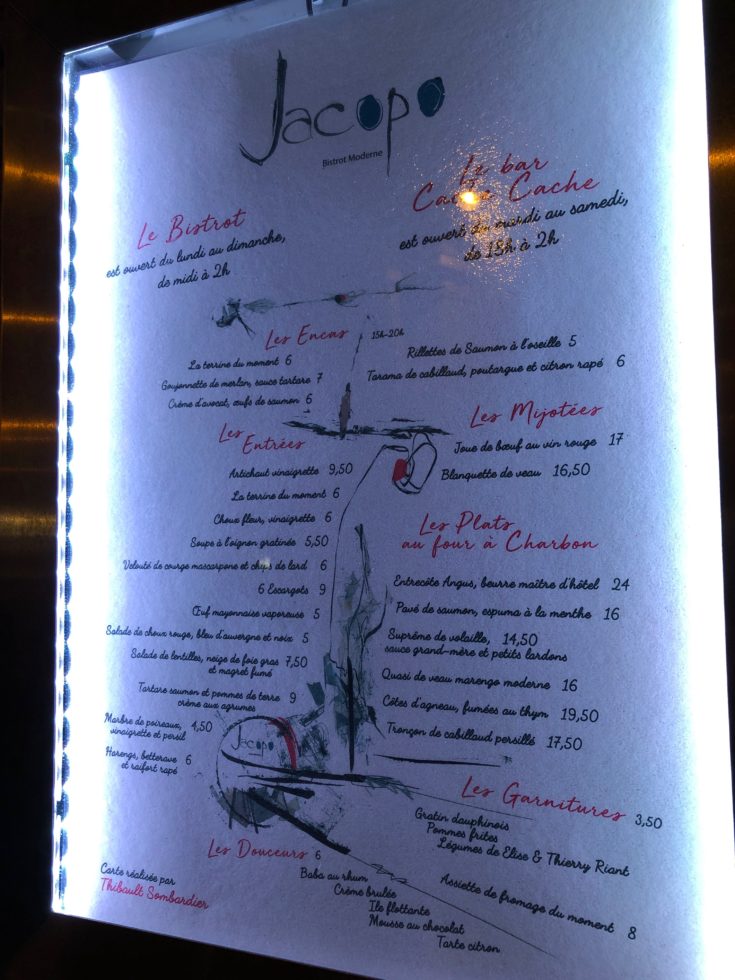
Who knows, I thought as I arrived at the door of Jacopo, maybe if half-decent reasonably priced French food had been easy for us to find all of those years ago, my Parisian learning curve would have had a different point of departure. As is my habit, I read the menu before going inside to meet my friend, and it looked promising—there were lots of things I’d happily eat—and it was indeed quite reasonably priced, too. The long narrow dining room was rather odd-looking, however. With exposed cement walls and ceiling, bright modern lighting fixtures, dark stained parquet floors and Navy blue Fiberglas chairs at small metal edged tables, it looked more like a sports bar in a Sunbelt city than a bistro.
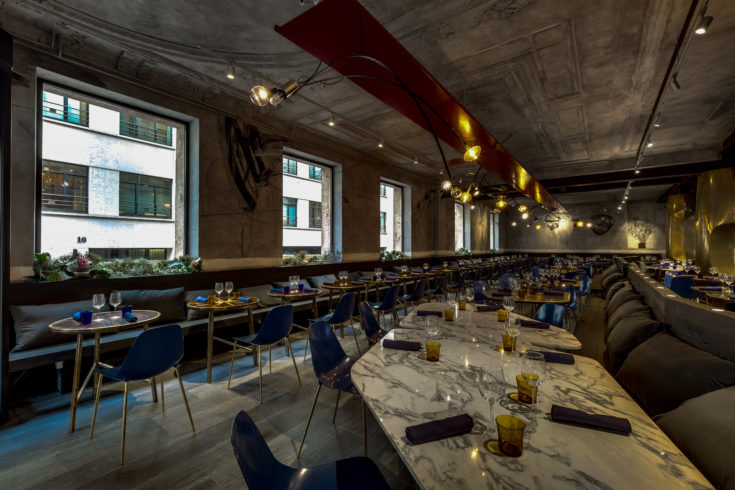
The joint was jumping, though, with a happy mixture of after-work office friends, tourists, and some French out-of-towners who’d must have heard about the place via word-of-mouth. Over a nice pour of Petit Chablis for 7 Euros a glass, a price that sort of par for the game in any central Paris neighborhood if you’re drinking better than plonk, my friend and me studied the menu and the crowd. We were fish out of water here, you see, because like most Parisians, we almost never find ourselves on the Champs Elysees for any reason that doesn’t have to do with some business-specific errand. Though the city of Paris has made a huge effort to enhance and renew the appeal of the avenue, it’s just not a place Parisians gravitate to, because they’ve long since written it off as tourist turf, or sort of a much better looking and considerably less illuminated Gallic version of Times Square in New York City.
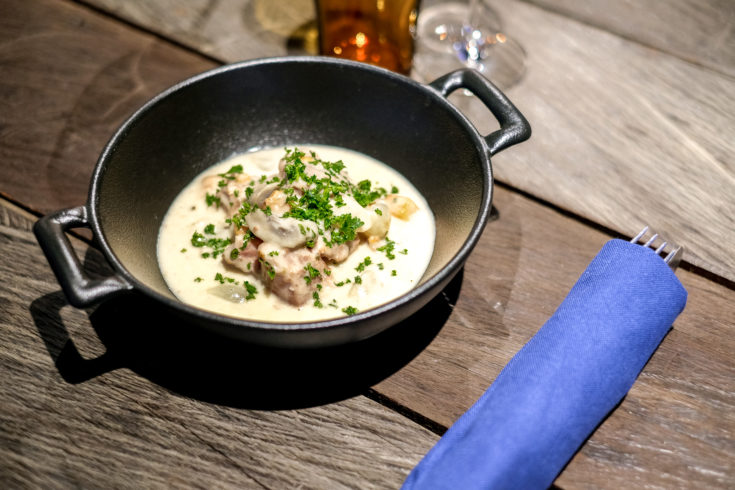
I decided to order a meal that was as French at Vercingetorix, the great hero of the Gauls. To wit, onion soup and blanquette de veau, while my friend opted for the oeufs mayonnaise—hard-boiled eggs with mayonnaise, another dish as Gallic as Charles de Gaulle’s nose, and cod persille (parsley butter with tomatoes and bread crumbs). Then I glanced at the wine list, which was where I expected the restaurant would be making its margins, and they so they did. If there was one white at 25 Euros a bottle and a red at 24 Euros, it was an expensive roster, an off-page nod at the rents in this very expensive part of Paris and perhaps targeted at a business crowd at noon. Still, two people having a three-course meal and sharing a bottle of wine could get away for about 35 Euros a piece here, and cheaper still with just a glass of wine with their meal.
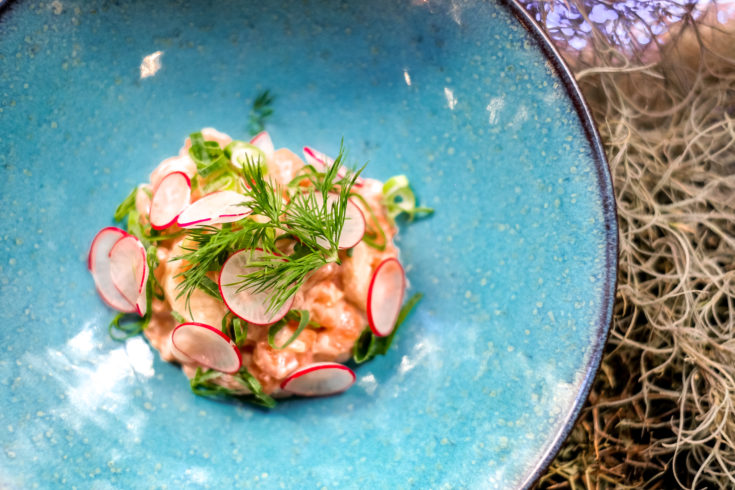
Salmon tartare
That’s when it occurred to me: We were having dinner in a French version of the Olive Garden (a popular chain of moderately priced fast-casual Italian restaurants in the United States), or a sort of fast casual pastiche of a real bistro designed to deliver familiar affordable indigenous comfort food at easy prices in a setting that forsook the touristy memes of white laces curtains and red-checked table cloths. And this is when the meal suddenly became really interesting, because even if the French supposedly consumed more hamburgers last year than they did jambon beurre, the famous sandwich made with baguette, ham and salted butter, the success of this no-reservations restaurant is a reflection of a deep yearning for the type of traditional French dishes that few middle-class people in France have the time to prepare anymore and which are now most often found in a handful of expensive tourist-oriented bistros in Paris. But would the food be good at Jacopo?
Our first courses were not promising, to say the least. My onion soup was unpleasantly sweet, which made me less unhappy that it had been served in such a stingy bowl, and was garnished with a large obviously pre-made crouton topped with dried out melted cheese. More puzzlingly, the oeufs mayonnaise were frankly terrible; the three egg halves (what happened to the fourth one?) were overcooked and topped with a thick flavorless foam that had no resemblance to mayonnaise whatsoever. “You can’t expect miracles for these prices,” my pal commented as she observed my optimism deflating. Except, that is, when you can.
My blanquette de veal was so good that I knew that if I found myself at lose ends for a meal in this part of town, I’d pop in to Jacopo again just to eat this delicate stew of tender meat, onions, mushrooms and carrots in a silken and light but flavorful cream sauce.
“This is really good,” I told my pal.
“No!”
“Yes! Have a taste,” I said, and she did.
“It is good, but my fish is overcooked and has no flavor.”
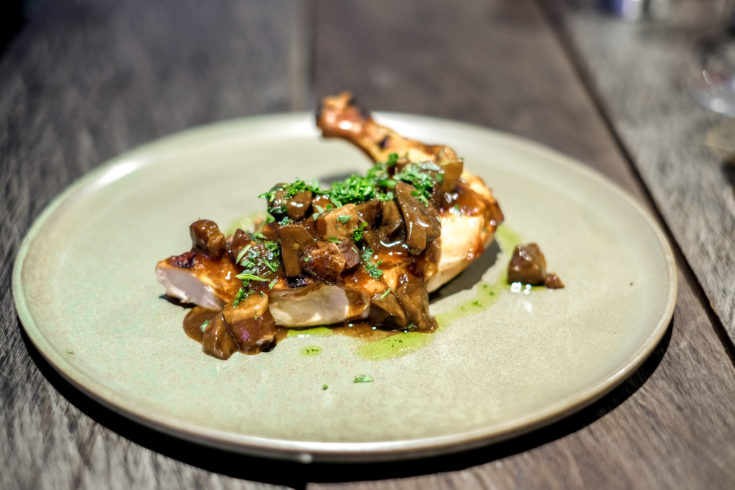
A shared and rather sad baba au rhum concluded this gastronomic foray, and I went off into the night undecided about the utility of this place, because on the one hand, it was better than the fast food places and chain restaurants on the Champs Elysees, and also relatively affordable, and on the other, the cooking was decidedly hit and miss.
Fast forward two weeks. On a rainy day around noon, I found myself in this neighborhood again when I went to collect a travel visa from an embassy located here, and as it started to pour, I found myself standing hungry near the doors of Jacopo just as it opened for lunch, and thought, Why not?
This time round, a steamed artichoke with a vinaigrette sauce as a starter, chicken breast in a nicely made sauce with baby lardons and mushrooms and surprisingly good frites brought on the same sort of pleasantly muddled satisfaction I used to feel many many years ago when I ate at…Howard Johnson’s, the sadly now defunct, solidly middle-class, middle-of-the-road Quincy, Massachusetts based restaurant chain that passed as a treat for their fried clam plates and peppermint-stick ice cream with hot fudge-sauce sundaes.
Everything wasn’t good at Howard Johnson’s—you had to know what to order, and the same thing is true of Jacopo, which is nobly catering to a similar demographic niche, too. To wit, if you know what you’re doing, you can have a perfectly pleasant meal here, especially for this part of Paris. My late father would have loved it.
5bis rue Vernet, 8th Arrondissement, Tel. (33) 01-42-89-20-22, Metro: George V. Open daily for lunch and dinner. Average 35 Euros. www.jacopo.fr




